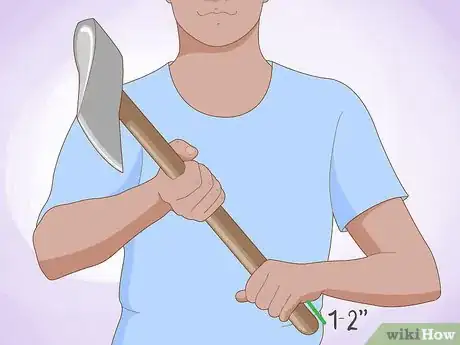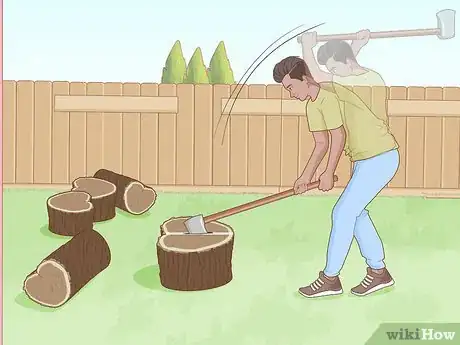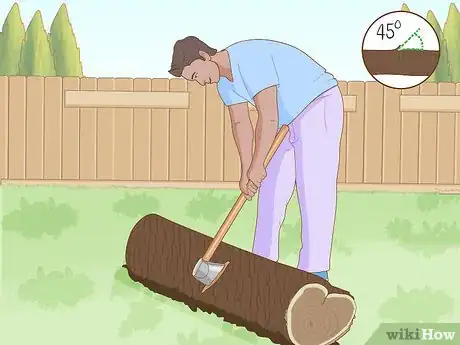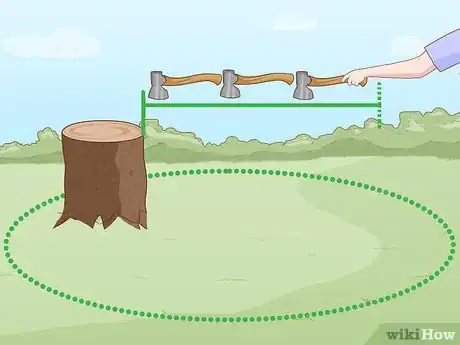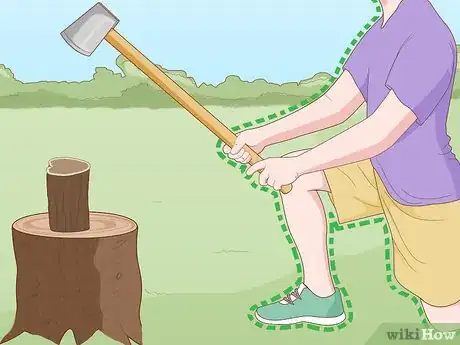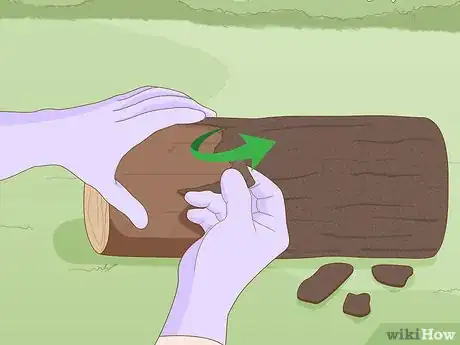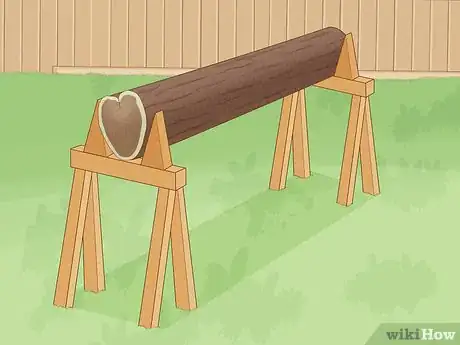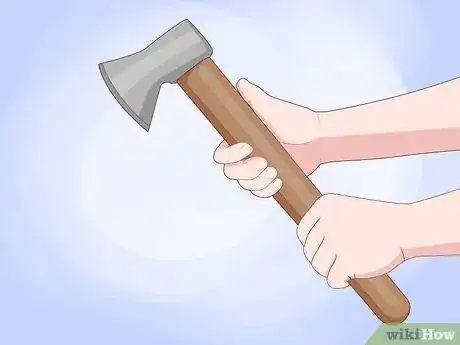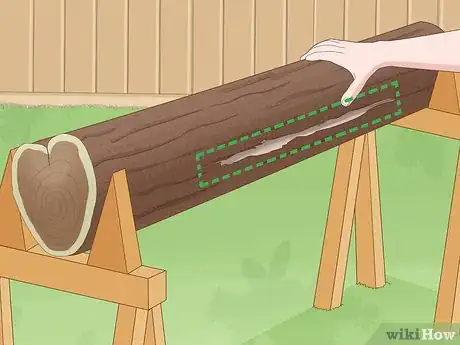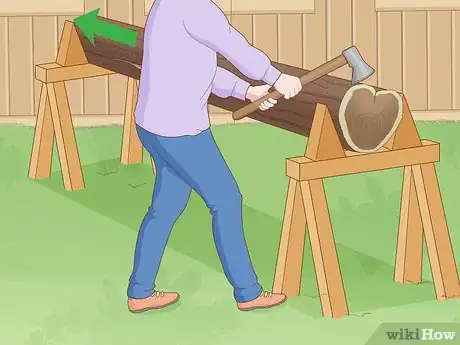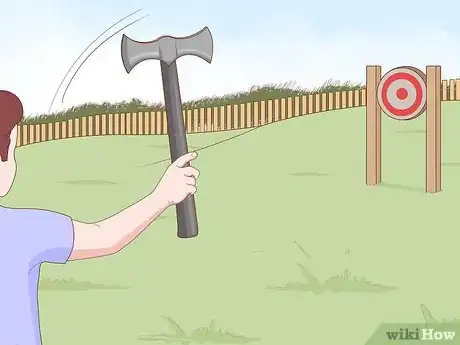This article was co-authored by wikiHow Staff. Our trained team of editors and researchers validate articles for accuracy and comprehensiveness. wikiHow's Content Management Team carefully monitors the work from our editorial staff to ensure that each article is backed by trusted research and meets our high quality standards.
There are 9 references cited in this article, which can be found at the bottom of the page.
This article has been viewed 70,376 times.
Learn more...
Axes come in a variety of sizes and serve many different purposes. A forest axe (also known as a range axe) is used to cut or split large pieces of wood and requires both hands to use. A hatchet, or hand axe, is appropriate for cutting dead branches, twigs, and firewood, and can be used with one hand. Axes can help with numerous tasks, including log-building and meat cleaving, and it’s important to know how and when to use different types of axes!
Steps
Using a Forest Axe or Range Axe
-
1Hold the axe tightly. Your body should be loose and relaxed, while your hands need to firmly grip the axe itself. Make sure your hands are a few inches apart on the axe handle before you start chopping.[1]
- Grab the axe by placing your non-dominant hand 1 to 2 inches (2.5 to 5 cm) above the end of the axe handle.
- Position your other hand approximately 25% down the handle below the blade of the axe.
- If you are right-handed, your right hand should be the one closest to the blade. If you are left-handed, the opposite is true.
-
2Chop the wood in a cautious, controlled manner. Accuracy is more important that power, so there’s no need to overswing. Glide the hand that is closest to the blade down towards the end of the handle as you swing the axe. The top hand should come down the handle and meet the bottom hand by the time you have finished the swing.[2]
- To help with accuracy, make a chalk mark where you want to chop the wood.
Advertisement -
3Swing the axe to chop into the wood at a 45-degree angle. Stand directly over the wood as you do this. Always leave part of your axe blade exposed and not touching the wood. This will ensure that your axe does not get stuck.[3]
- Aim your swing for the top, middle and bottom portion of each side of the spot where you are cutting the wood.
-
4Alternate swinging the axe from the left and right sides of the target on the wood. Bring the axe up over your left and right shoulder, switching from one side to the other as you bring the axe down on each side of the target spot on the wood.[4]
- Not only does this technique help you chop the wood faster, it puts less stress on both sides of your body and allows you to chop for longer periods of time.
-
5Repeat this swing pattern until you have chopped through the wood. Stay consistent with the placement of your strokes. The more accurate you are, the quicker the job gets done![5]
- It is smart to do all of your chopping either right or left-handed, whichever is your natural swing.
- In the long run, it is important to learn how to chop with both your right and left hand. This will make you a more efficient chopper and save lots of time.
Working with a Hatchet or Hand Axe
-
1Set up the wood on a chopping block. A chopping block could be the base of a tree or a sturdy table. It should be right in the middle of the chopping area. Take time to mark out a clear chopping area that is free of obstructions and trip hazards.[6]
- The distance from the chopping block to the edge of the chopping area is roughly the distance of an outstretched arm plus the length of three axes.
-
2Lower yourself onto one knee next to the chopping block. Putting yourself on one knee helps balance your body as you go to chop. Don’t crouch like a baseball catcher or go down on both knees, since that can throw off you’re your balance.[7]
- If you’re a righty, your right knee should be on the ground. If you’re a lefty, your left knee should be on the ground.
-
3Use your off hand to steady the wood. Hold the axe firmly with the other hand. Keep your off hand near the base of the wood you’re about to chop.[8]
- Under no circumstances should you steady the wood by placing your hand near the top of the piece of wood. Keep your off hand as far away from the axe as possible to avoid accidents.
-
4Swing down in the same spot every time when chopping. Bend at the elbow to swing while keeping your wrist and hand straight. Aim carefully and chop the wood until you have cut it into two pieces.[9]
- Alternate bringing the axe down onto the right and the left sides of the targeted area on the wood. A “V” will emerge in the wood.
- Keep your eyes on the target area on the wood as you swing.
- Do not chop straight down, as this will cause the axe head to bounce and could lead to serious injuries.
-
5Sweep the chopping block to remove excess wood. Sweep the wood chips off of the chopping block with your hand. You can use the chips as kindling, as a hatchet is the perfect size for splitting kindling for a fire.[10]
- To avoid splinters, wear gloves when clearing off your chopping block.
Chopping Logs with Your Broad Axe
-
1Place the ends of the log on stands. Then, put a wedge on both ends of the log to lock it in place. These stands should be tall enough to have the log sit close to hip-level, but no taller than that. You should be able to sit astride the log and have your feet flat on the ground. [11]
- Sitting astride means placing your legs on either side of the log and sitting on the log itself. If your feet are not flat on the ground, the stands are too tall. You will need to replace them with shorter stands if this is the case.
-
2Grip the part near the head of the axe with your dominant hand. The thumb of your dominant hand should lay on the shoulder of the handle. If you have your thumb around the handle, you risk injuring your thumbnail.[12]
- Your off hand should be right underneath your dominant hand. Have the bottom of your dominant hand touching the top of your off hand for maximum axe control.
-
3Examine the log to see which direction you need to chop. If the log has cracks in it going downward from left to right, you must hew away from you on the upper part of the log and towards the lower part. If the log has cracks that go upward from left to right, you’ll have to hew in the opposite direction.[13]
- Doing this avoids conflicting with the structure of the wood and gives you the cleanest chop possible.
-
4Move backwards slowly to check your progress. This lets you check the quality of the surface you’ve hewn. Chop as evenly as possible to repel water as best as you can.[14]
- Flakes of wood can create pockets for rainwater, so place the log upside-down before you hew it.
Choosing a Different Type of Axe
-
1Try a Double Bit axe for throwing. This type of axe used to be very common in the forest, where workers would use one side for felling trees and the other side for limbing them. Nowadays, these tools are used for the sport of axe throwing. Contestants aim for a target about 20 feet away and try to hit the center of it.[15]
- If you are going to do this activity, make sure you are with people who have experience throwing axes.
- Never attempt a throw unless you are absolutely sure no one is within three meters behind you, eight meters to the side of you, or 15 meters behind your target.
-
2Utilize an ice pick for mountain climbing. Ice picks have been used for centuries to help climbers scale and descend mountains. To use it as a walking stick, hold the center of the head. It also works for cutting out steps in icy slopes and catching yourself if you slip.[16]
- Ice picks used to be made with a wooden handle, but now they are required to have a metal handle.
-
3Break out a fire axe in case of an emergency. Fire axes are used to chop down doors and windows when an emergency occurs. The top hand should be right below the axe head, while the bottom hand should be near the base of the handle. Swings should be short, compact, and accurate.[17]
- Make sure your hands are comfortably spaced on the axe handle. This gives you better control of the axe.
-
4Work with a meat cleaver when cooking big meals. Meat cleavers are perfect for large ingredients, such as whole lobsters, whole chickens, or big squashes. If you make a lot of stock, using a cleaver is great because it lets you expose more of the bone and meat to the water for premium flavor extraction.[18]
- Cleavers are good for other tasks as well, like mincing raw meat, crushing garlic, or cracking coconuts.
Things You'll Need
- Forest axe, hatchet, or other type of axe
- Wood to chop
- Chopping block
References
- ↑ https://www.fhwa.dot.gov/environment/recreational_trails/publications/fs_publications/99232823/page17.cfm
- ↑ https://www.fhwa.dot.gov/environment/recreational_trails/publications/fs_publications/99232823/page16.cfm
- ↑ https://www.fhwa.dot.gov/environment/recreational_trails/publications/fs_publications/99232823/page16.cfm
- ↑ https://www.fhwa.dot.gov/environment/recreational_trails/publications/fs_publications/99232823/page16.cfm
- ↑ https://www.fhwa.dot.gov/environment/recreational_trails/publications/fs_publications/99232823/page17.cfm
- ↑ https://members.scouts.org.uk/factsheets/FS315070.pdf
- ↑ https://members.scouts.org.uk/factsheets/FS315070.pdf
- ↑ https://members.scouts.org.uk/factsheets/FS315070.pdf
- ↑ https://members.scouts.org.uk/factsheets/FS315070.pdf
- ↑ https://survivalcache.com/survival-axe/
- ↑ https://www.gransforsbruk.com/en/axe-knowledge/using-an-axe/log-building/
- ↑ https://www.gransforsbruk.com/en/axe-knowledge/using-an-axe/log-building/
- ↑ https://www.gransforsbruk.com/en/axe-knowledge/using-an-axe/log-building/
- ↑ https://www.gransforsbruk.com/en/axe-knowledge/using-an-axe/log-building/
- ↑ https://www.gransforsbruk.com/en/axe-knowledge/axe-throwing/
- ↑ https://www.gransforsbruk.com/en/axe-knowledge/the-history-of-the-axe/
- ↑ https://www.firerescuemagazine.com/articles/print/volume-9/issue-5/training-0/effective-and-safe-use-of-axes-on-the-fireground.html
- ↑ https://www.cooksillustrated.com/equipment_reviews/1838-meat-cleavers
